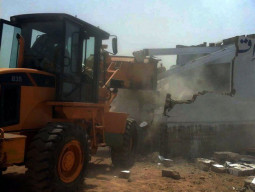
In the post-2005 earthquake scenario, significant financial resources were spent to establish disaster management authorities at the national and provincial levels. These resulted in the formation of the National Disaster Management Authority (NDMA) and the Provincial Disaster Management Authorities (PDMAs).

Countless disaster and emergency response scenarios and detailed contingency plans were prepared. However, when the time came to implement such plans such as in the case of the floods in 2010 and 2011, these institutions and plans failed to deliver. Ultimately, it was the paramilitary and army support that was sought to manage the immediate crisis.
There are many reasons for this. For one, while these high profile institutions were being established, no real effort was made to strengthen the existing relevant institutions such as the fire-fighting services coming under the control of the city governments, the institution of civil defence that for all intents and purposes has ceased to exist, emergency health care and trauma facilities, paramedic staff and even voluntary support services such as national scouts service. No one knows if the scouting tradition is even being followed in this country any more.
If one studies efficient emergency response and management services in other countries, it is the city government and allied services like the civil defence and healthcare facilities that take the lead in immediate damage control and rescue operations. It is only in case of major disasters that specialised institutions come into action. In the USA for example, the Federal Emergency Management Agency (FEMA) is deployed only after the President declares an emergency for that area.
We, on the other hand, have simply allowed a continuous decline in the capacity and efficiency of our city-based emergency response infrastructure. Furthermore, there is no coordinated response system to handle such scenarios as was evident in the unfortunate episode at the Karachi Airport.
Jinnah Postgraduate Medical Center and Civil Hospital, Karachi, conducted a cross-sectional survey of postgraduate trainees to evaluate the preparedness and self-identified deficiencies of doctors involved in massive trauma casualty management. Of the 90 respondents questioned, only three (3.3%) of them were confident about the management of bomb blast victims. Eighty-seven (96.6%) of the respondents felt they required some further training (44.4%) or comprehensive training (52.2%). No simulated drills or courses had been conducted for disaster management in the emergency department of the surveyed hospitals.
Most of the ambulance drivers had no paramedic training. Ambulances were equipped with a stretcher and an oxygen cylinder only. No resuscitation measures were found available in the ambulances.
With regards to fire services, in a presentation made by Muhammad Masood Alam, the executive district officer of the City District Government’s Municipal Services Group of Offices in 2011, no fire hydrant system is available anywhere in the city. The firefighters are not trained as per international standards and there are also no institutes to train them. There is no implementation of safety rules and the stations are under-staffed and lack proper resources. Effective coordination and cooperation mechanisms of different agencies on the scene of incident are also non-existent.
It is high time that the government takes effective steps to improve the capacity, efficiency and scope of action of institutions based at the level of immediate response such as the city government services, rather than investing in institutions and bureaucracies that are never to be found in times of crisis. That is not to say that they should not exist, but the priority of investment in training, building coordinative mechanisms and equipment upgrade lies elsewhere.
Farhan Anwar is an urban planner and runs a non-profit organization based in Karachi city focusing on urban sustainability issues.
Published in The Express Tribune, June 16th, 2014.



1732263441-0/BeFunky-collage-(81)1732263441-0-165x106.webp)
1732263755-0/musk-(3)1732263755-0-165x106.webp)












COMMENTS
Comments are moderated and generally will be posted if they are on-topic and not abusive.
For more information, please see our Comments FAQ